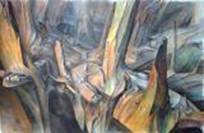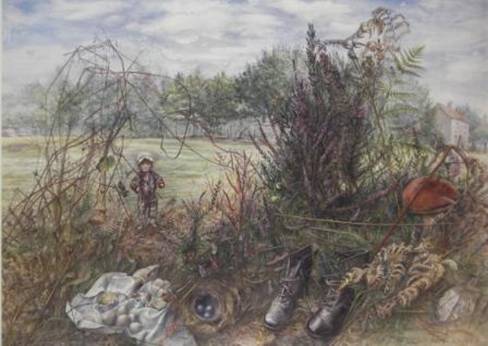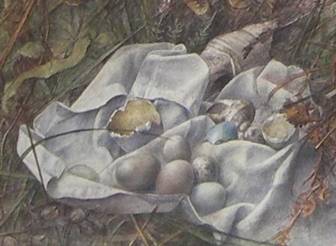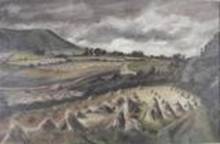|
Elizabeth Sorrell Artist 1916-1991 |


|
Home Page |
|
The Collector (detail) Watercolour , 1983
Such details show the unbelievable skill and meticulousness of Elizabeth Sorrell’s work.
|
|
This website provide will provide biographical information about the life and work of Elizabeth Sorrell RWS. For further information, please contact Julia Sorrell
March 2009
Updated June 2009 |

|
“Woodscape V” by Julia Sorrell . Click on the (left) image to hyperlink to www.juliasorrell.ukartists.com |
|
Contact details:
Contact Julia Sorrell on: 01953 498736
e.mail: Juliasorrell’at’ ukartists.com
Please replace the ‘at’ with an @, this is measure to reduce spam. We apologise for the inconvenience.
|



|
Self-Portrait byAlan Sorrell Oil, 1971 In the studio at Thors Mead with Julia in the background
Click on the image (left) to link to Www.alansorrell.ukartists.com |
|
Hyperlinks (within the images below) to websites relating to Elizabeth Sorrell or illustrating her work: |

|
Haymaking, probably the Sussex Downs
An early work by the then Elizabeth Tanner. The Tate possess a work by Elizabeth from the same period. The image left is a link to the Tate Gallery website. If you type in Elizabeth Sorrell to their search engine, you will get through the Elizabeth Sorrell page. Unfortunately, a direct link to this page does not work. |
|
Early in her painting career, she used touches of opaque Chinese white, but she soon abandoned this; instead leaving areas of the drawing paper black for her whites. She often said that watercolour painting was an exacting medium, because unlike oil painting, you could not afford to make mistakes, or rather, you could not hide them. Her paintings seemed to grow almost organically, a few inches at most being added—and left complete—each day. Apart from her skies, she rarely used washes, the paint being applied nearly dry, and with the finest ‘00’ brushes. This technique almost obliged her to be studio-bound, sitting day after day in front of her selected subject matter. Outdoors, in summer, she painting pieces of the landscape, a row of trees with their with their browsing line; a lane; a bit of salt marsh; a corner of a garden. Enclosure and containment were essential elements of her vision of the ideal world.
Mark Sorrell (Aug 07) |
|
Berries; dried seed-heads—cardoon, honesty, Chinese lanterns, giant poppy; wave-smoothed ‘found objects’; scraps and fragments of this and that; complex natural forms—briars, convolvulus, tall field grasses; petals; lace; silk; the shadows in cloth folds which she rendered with such technical virtuosity; the brilliant white glazes of Staffordshire figures; the painted china of dolls’ faces—these are all recurring motifs in Elizabeth Sorrell’s watercolour paintings. Often, in the background (or occasionally as paintings in their own light), there are glimpses of a landscape of fields and trees—the Essex landscape which lay outside the studio windows. |
|
The Collector Watercolour , 1983 20” x 28”
|
|
Hers was essentially an art of the still life, based on a selection of real things. Elizabeth Sorrell was decidedly not a sketchbook artist; indeed, I cannot recall that she ever made a preparatory drawing, although her large paintings might take several months to complete. She worked exclusively in watercolour, but she devised a working method that was a long way from the norm of watercolourists. |